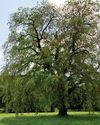
THE origin of the hall house stems from house-naming conventions in Anglo-Saxon times, explains the team at traditional interior-joinery and kitchen-maker Artichoke. ‘The original hall buildings were meeting places and they usually consisted of four walls, a roof and a single hearth around which to gather. Because of the fire, they usually had very high ceilings, which were often later filled in with floors.’
During the high Middle Ages, great halls existed within every kind of residence, from palaces and castles to merchant houses and farms. In Kent, where there was a strong tradition of timber building, it’s estimated that 2,500 hall houses survive, dating from between 1370 and the 16th century, according to Historic England. One of the best preserved is Penshurst Place near Tonbridge, which illustrates the classic features of a high medieval great hall.
The addition of further floors with rooms and extensions beyond often renders the medieval hall house unrecognisable today— if any of the original building has survived at all. However, the name lived on long after great halls ceased to be a defining feature of the English country house and a manor house is still often called ‘The Hall’, in reference to the chamber that was once the main architectural symbol of the household.
Bu hikaye Country Life UK dergisinin April 05, 2023 sayısından alınmıştır.
Start your 7-day Magzter GOLD free trial to access thousands of curated premium stories, and 9,000+ magazines and newspapers.
Already a subscriber ? Giriş Yap
Bu hikaye Country Life UK dergisinin April 05, 2023 sayısından alınmıştır.
Start your 7-day Magzter GOLD free trial to access thousands of curated premium stories, and 9,000+ magazines and newspapers.
Already a subscriber? Giriş Yap

A leap in the dark
The primal play of light and shadow, whether in Leonardo's ever-so-subtle sfumato or Caravaggio's dramatic contrasts, has shaped Western art, as Michael Hall reveals

Beauty and the blimp
Inflammable airships may be gone, but a new hybrid aircraft, capable of delivering eco-friendly aviation, is set to take to the skies with a bang, finds Charles Harris

Three wishes for food and farming
Royal hedge planting, the terrible toll on Ukrainian farming and a maiden speech

Seeing the wood for the trees
Scotland's much-evolved forestry industry has become a focus for clever investors

Let's fall in love
Birds do it, bees do it, even educated fleas do it. Laura Parker finds that, when it comes to creatures mating for life, persistence, patience and a little dad dancing are key to success

Back from the dead
THREE Wentworth elm saplings have been planted in the grounds of the Palace of Holyroodhouse, Edinburgh, and on the Highgrove estate in Gloucestershire-29 years after what was thought to be the lastknown Wentworth elm died.

A man among men
What makes a master? Beloved of the commercial art world, handled warily by art historians, the word has long been opaque. Michael Prodger investigates its many meanings-and discovers that being male confers an unfair advantage

Unearth one of life's luxuries
Black diamonds are a girl's best friend this Valentine's Day, with Périgord truffle-based skincare from TRUFFE

Adventure awaits
Spend an unforgettable family holiday on the Benmore Estate and experience some of Scotland's finest wildlife and sporting activities

Let the art rule the head
Despite being a world leader in everything from jewellery to fashion and music, the UK is failing to nurture creativity at school and in regional centres. Tristram Hunt, director of the V&A Museum, calls for an urgent review